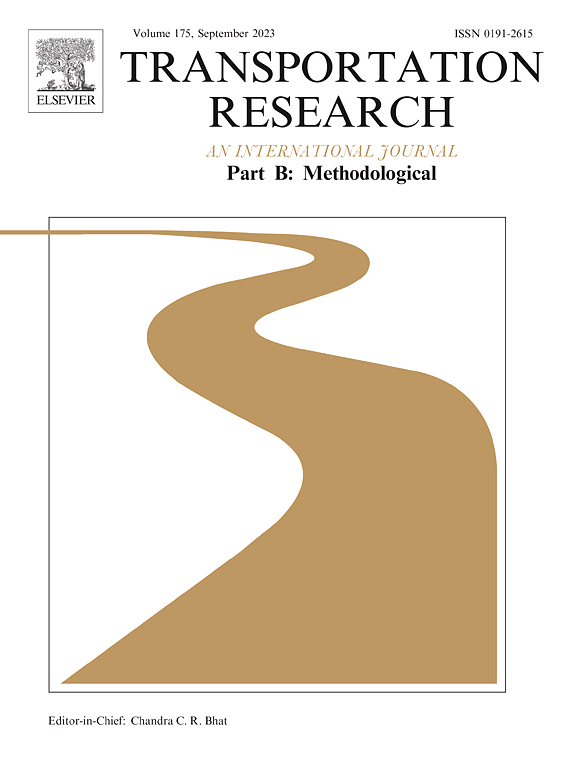Conflict-free optimal control of connected automated vehicles at unsignalized intersections: A condition-based computational framework with constrained terminal position and speed
IF 6.3
1区 工程技术
Q1 ECONOMICS
引用次数: 0
Abstract
Conventional intersection management relies on traffic signals to coordinate conflicting traffic flows and distribute right-of-way. However, delays caused by traffic signals remain a major burden on urban transportation systems. Emerging connected automated vehicles (CAVs) are expected to improve the intersection management by coordinating vehicle movements without relying on traffic signals. Hence, this paper primarily focuses on coordinating CAVs at unsignalized intersections, especially common unsignalized intersections composed of major and minor roads, which exhibit inherent asymmetries such as higher speed limits and vehicle arrival rates on major roads compared to minor roads. We propose a conflict-free optimal control method to achieve highly efficient coordination of CAVs at these unsignalized intersections. The method employs a hierarchical coordination framework, in which an upper layer optimizes the passing order for CAVs through the intersection, and a lower layer designs a second-order optimal control model with constrained terminal position and speed for trajectory planning. Specifically, the upper layer adopts an improved Incremental Learning Monte Carlo Tree Search to efficiently generate a nearly global-optimal passing order for CAVs within a very short planning time. The lower layer introduces a condition-based computational framework that enhances the standard iterative solution procedure used in the constrained Hamiltonian analysis, and derives a closed-form analytical solution for the constrained optimal control problem without any recursive steps. The results of numerical experiments show that the proposed method can achieve real-time conflict-free optimal trajectory planning for all CAVs. Compared with fully-actuated signal control, the proposed method reduces the average delay for all CAVs by , , and under both symmetric and asymmetric traffic demands (i.e., the ratios of CAV arrival rates on the major to minor roads are 1:1, 2:1, and 3:1, respectively).
无信号交叉口网联自动驾驶车辆无冲突最优控制:终端位置和速度受限的基于条件的计算框架
传统的交叉口管理依靠交通信号来协调冲突的交通流和分配路权。然而,交通信号造成的延误仍然是城市交通系统的主要负担。新兴的互联自动驾驶汽车(cav)有望在不依赖交通信号的情况下,通过协调车辆运动来改善交叉口管理。因此,本文主要关注无信号交叉口的自动驾驶汽车协调问题,特别是由主干道和次要干道组成的普通无信号交叉口,这些交叉口表现出固有的不对称性,例如主干道上的限速和车辆到达率高于次要干道。我们提出了一种无冲突最优控制方法,以实现自动驾驶汽车在这些无信号交叉口的高效协调。该方法采用分层协调框架,上层优化自动驾驶汽车通过交叉口的顺序,下层设计具有约束终端位置和速度的二阶最优控制模型进行轨迹规划。具体而言,上层采用改进的增量学习蒙特卡罗树搜索,在很短的规划时间内有效地为cav生成接近全局最优的通过顺序。底层引入了一个基于条件的计算框架,增强了约束哈密顿分析中使用的标准迭代求解过程,并推导出约束最优控制问题的封闭解析解,无需任何递归步骤。数值实验结果表明,该方法可以实现所有自动驾驶汽车的实时无冲突最优轨迹规划。与全驱动信号控制相比,该方法在对称和非对称交通需求下(即在主干道和次要道路上CAV到达率分别为1:1、2:1和3:1),使所有CAV的平均延迟分别减少19.92s、16.46s和15.47s。
本文章由计算机程序翻译,如有差异,请以英文原文为准。
求助全文
约1分钟内获得全文
求助全文
来源期刊
CiteScore
12.40
自引率
8.80%
发文量
143
审稿时长
14.1 weeks
期刊介绍:
Transportation Research: Part B publishes papers on all methodological aspects of the subject, particularly those that require mathematical analysis. The general theme of the journal is the development and solution of problems that are adequately motivated to deal with important aspects of the design and/or analysis of transportation systems. Areas covered include: traffic flow; design and analysis of transportation networks; control and scheduling; optimization; queuing theory; logistics; supply chains; development and application of statistical, econometric and mathematical models to address transportation problems; cost models; pricing and/or investment; traveler or shipper behavior; cost-benefit methodologies.

 求助内容:
求助内容: 应助结果提醒方式:
应助结果提醒方式:


